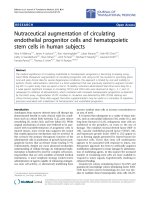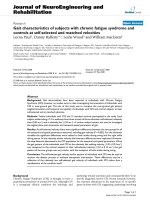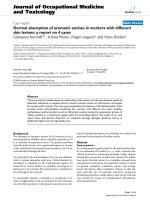báo cáo hóa học:" Performance characteristics of polymer photovoltaic solar cells with an additiveincorporated active layer" pdf
Bạn đang xem bản rút gọn của tài liệu. Xem và tải ngay bản đầy đủ của tài liệu tại đây (927.98 KB, 5 trang )
NANO IDEA Open Access
Performance characteristics of polymer
photovoltaic solar cells with an additive-
incorporated active layer
Hyomin Kim
†
, Sunseong Ok
†
, Hyunhee Chae
†
and Youngson Choe
*
Abstract
We have investigated the performance characteristics of bulk-heterojunction polymer solar cells based on poly(3-
hexylthiophene-2,5-diyl) and [6,6]-phenyl C
61
butyric acid methyl ester by adding 1,8-octanedithiol as a processing
agent in an active layer. The effects of the additive, 1,8-octanedithiol, on the device performance parameter
characteristics have been discussed. The current density-voltage measurements, UV-Vis absorption spectra, X-ray
diffraction spectra, and scanning probe microscope images have been used to discuss the performance
characteristics of polymer solar cells.
Keywords: bulk heterojunction, power conversion efficiency, polymer solar cell, excitons
Background
Clean and renewable energies have been considerable
issues in the last decade. For this reason, organic photovol-
taic cells have been attractive devices as next-generation
substitute energy sources [1-4]. Currently, the power con-
version efficiencies of organic photovoltaic cells have been
steadily improved around 6% through polymer solar cells
[5]. There have been reports that polymer solar cells have
many advantages of cost-effectiveness in the fabrication
process, and the mechanical flexibility and polymeric
materials provide a wide field of applications [6,7].
Bulk-heterojunction [BHJ] solar cells, based on phase-
separated blends of polymer semiconductors and fuller-
ene derivatives, typically consist of a conjugated polymer,
poly(3-hexylthiophene-2,5-diyl) [P3HT] as an e lectron
donor, and fullerene derivatives, [6,6]-phenyl C
61
butyric
acid met hyl ester [PCBM] as an electron acceptor [8-12].
Especially, P3HT has attracted lots of interest due to its
high crystallinity and self-assembling property . In sup-
porting P3HT crystallite formation, PCBM should be dis-
persed between P3HT chains [13]. For this, thermal and
solvent annealing can be used to improve their roles
between P3HT and PCBM [14,15]. Recently, a small
volume ratio of additives suchas1,8-octanedithiolhas
been incorporated into the P3HT:PCBM system to
improve the interactions between P3HT and PCBM [16].
In this work, we have fabricated BHJ solar cells based
on P3HT and PCBM, which were dispersed using a sin-
gle solvent, chlorobenzene and 1,2-dichlorobenzene. The
effects of the additive, 1,8-octanedithiol, on the perfor-
mance characteristics of polymer solar cells have been
investigated. The results of current density-voltage [J-V]
measurements, UV-Visible [UV-Vis] absor ption spectra,
X-ray diffraction [XRD] spectra, and scanning probe
microscope [SPM] images will be intensively used to
discuss the performance characteristics of polymer solar
cells fabricated in this study.
Methods
BHJ films were prepared via a solution process. P3HT
(Rieke Metals, Inc., Lincoln, NE, USA) a nd PCBM
(Nano-C, Westwood, MA, USA) with a 1:1 wt/wt ratio
was dissolved in chlorobenzene and 1,2-dichlorobenzene
to make a 2.4 wt.% solution. The blend solution was
stirred for 24 h at 40°C in a shaking incubator. 1,8-
Octanedithiol (formula C
8
H
18
S
2
, molecular weight
178.36 g/mol, boiling point 269°C to 270°C, density,
0.97 g/mL at 25°C, Sigma-Aldrich Corporation, St.
Louis, MO, USA) and 1,8-diiodooctane (formula
C
8
H
16
I
2
, molecular weight 366.02 g/mol, boiling point
* Correspondence:
† Contributed equally
Department of Chemical Engineering, Pusan National University, Busan, 609-
735, South Korea
Kim et al. Nanoscale Research Letters 2012, 7:56
/>© 2012 Kim et al; licensee Springer. This is an Open Access article distributed under the terms of the Creative Commons Attribution
License (http://creative commons.org/lic enses/by/2.0), which permits unrestricted use, distrib ution, and reproduction in any medium,
provided the original work is properly cited.
167°C to 169°C, density 1.84 g/mL a t 25°C, Sigma-
Aldrich Corporation) were selected as additives, and 2.5
vol.% additives were then added into the base solution.
The solution containing a mixture of P3HT:PCBM with
processing additives was stirred for 10 min. Polymer
solar cells were fabricated on the pre-patterned indium
tin oxide [ITO] glass substrate. Poly(3,4-ethylenedioxy-
hiophene):poly(styre nesulfonate) [PEDOT:PSS] was spin-
coated onto the ITO substrate at 3,000 rpm for 30 s,
and the prepared thin film was then baked at 120°C for
10 min on a hot plate in air. The prepared solution was
spin-coated onto the PEDOT:PSS layer at 1,000 rpm for
30 s, and then, the spin-coated thin film was dried in a
Petri dish. As a final step, an Al electrode was deposited
onto the spin-coated layer by thermal evaporation. The
fabricated devices were annealed at 120°C for 30 min.
An active area of the device, 2 mm × 2 mm in dimen-
sion, was made using a shadow mask. The J-V and
power conversion effic iency (h
e
) characteristics were
measured using a 2400 multi-source meter unit (Keith-
ley Instruments, Inc., Seoul, South Korea). A xenon
lamp (100 mW/cm
2
) was used as a light source, and the
light intensity has been measured by a silicon photo-
diode calibrated for an AM 1.5 spectrum. The absorp-
tion spectrum were taken using an Optizen 2120UV
spectrophotometer (Mecasys Co., Ltd., Daejeon, South
Korea); XRD images were obtained using a high-resolu-
tion X-ray diffractometer (Philips, Amsterdam, The
Netherlands); and SPM images were obtained using a
SPM (Multimode, Digital Instruments, Inc., Tonawanda,
NY, USA).
Results and discussion
The XRD spectrum of active layers, P3HT:PCBM films,
are shown in Figure 1. When the processing additive,
1,8-octanedithiol, was used, peak intensities were much
higher than those of the films without 1,8-octanedithiol,
and this implies that the P3HT:PCBM films possess a
crystalline nature and that highly ordered structures are
formed in the films using a processing additive. The crys-
tallinity of P3HT in the films significantly increases with
the presence of 1,8-octanedithiol. It implies that the
interaction between P3HT is stronger, and the size distri-
bution of P3HT crystals is broader with an increasing
amount of 1,8-octanedithiol. The processing additive,
1,8-octanedithiol, could provide a stronger driving force
for polymer aggregation. A highly orde red structure in
P3HT:PCBM films can provide short pathways to benefit
the carrier mobility.
Absorption spectra of active layers are shown in
Figure 2. As the amount of 1,8-octanedithiol was
increased in the BHJ film formation process, the absorp-
tion intensities were increased. P3HT:PCBM composite
films processed with 1,8-octanedithiol have s hown three
dominant features in absorption: two peaks at 510 and
550 nm and one shoulder at 610 nm appeared due to
strong interchain interactions. When adding 1,8-octane-
dithiol, the absorption band of P3HT:PCBM c omposite
film peaks are red-shifted, and the intensity of the
absorption band only increased with the increasing
amount of 1,8-octanedithiol. Such a shift on the absorp-
tion peak is associated with π-π* transition, indicating
that the P3HT chains interact more strongly. At the
presence of PCBM, a uniform dispersion of polymer
aggregates can be obtained. Therefore, it is considered
2 Theta (degree)
5101520253
0
no 1.8-octanedithiol
1.5 vol% 1.8-octanedithiol
2.5 vol% 1.8-octanedithiol
4.5 vol% 1.8-octanedithiol
5.5 vol% 1.8-octanedithiol
3.5 vol% 1.8-octanedithiol
Intensity (a. u)
Figure 1 XRD spectra of the devices solution-processed with
chlorobenzene and different amounts of 1,8-octanedithiol.
Wavelength (nm)
300 400 500 600 700 800
Absorption (O.D)
0.0
0.2
0.4
0.6
0.8
1.0
no 1.8-octanedithiol
1.5 vol% 1.8-octanedithiol
2.5 vol% 1.8-octanedithiol
3.5 vol% 1.8-octanedithiol
4.5 vol% 1.8-octanedithiol
5.5 vol% 1.8-octanedithiol
Figure 2 UV-Vis absorption spectra of the devices solution-
processed with chlorobenzene and different amounts of 1,8-
octanedithiol.
Kim et al. Nanoscale Research Letters 2012, 7:56
/>Page 2 of 5
that the addition of 1,8-octanedithiol helps the crystalli-
zation of P3HT as observed by the absorption spectrum.
From the SPM images, as shown in Figure 3, the growth
of polymer aggregates or clusters is clearly seen. The
aggregate size gets bigger with the increasing amount of
1,8-octanedithiol, consiste nt with t he higher crystallinity
observed in the XRD spectrum when i ncreasing the
amount of 1,8-octanedithio l.Theroughnessvalueand
aggregate size are very important because of the fact that
the exciton diffusion length in a polymer system is about 5
to 10 nm. Therefore, it is ne cessary to maintain a proper
size of the polymer aggregate because of an efficient disso-
ciation of excitons generated in the films to achieve higher
efficiency. A finely dispersed structure is observed when
there is no 1,8-octanedithiol. Thin fibrillar structures
appear when the amount of 1,8-octanedithiol reaches 1.5
vol.%, as shown in Figure 3, and Figure the P3HT domain
grows bigger when more than 1.5 vol.% 1,8-octanedithiol
is added.
The photoluminescence [PL] spectra of active layers are
shown in Figure 4. The PL intensity increased in the wave-
length range of 550 to 650 nm with the increasing amount
of 1,8-octanedithiol. A high PL intensity indicates that not
all excitons generated on one polymer within the film
reached the interface of the other polymers [17]. When
the conjugation length increases or when the domain size
of P3HT increases, the PL intensity of P3HT increases
[18]. An increase in the PL intensity suggests that PCBM
is not close enough to contact with P3HT to undergo a
charge transfer, and the interface area between P3HT and
PCBM is decreasing [19]. It is observ ed that more severe
phase separation occurred when more 1,8-octanedithiol is
added. It appears that after the exciton dissociates at the
P3HT:PCBM interface, an efficient carrier collection i s
required for a high performance of the device. When add-
ing an additive, carrier transport pathways, associated with
the crystallinity of P3HT , can be formed well. Through
the analysis results of the UV-Vis absorption and PL spec-
trum, it can be considered th at there is a proper point to
dissociate the exciton t o achieve higher device perfor-
mance. In addition, the growth o f P3HT domains is con-
sistent with the PL spectra results showing that the
interface area of P3HT and PCBM is decreasing and also
consistent with the XRD spectra (Figure 1), showing wider
polymer domain distributions.
Figure 3 SPM images of P3HT:P CBM films formed using
chlorobenzene with different amounts of 1.8-octanedithiol.
Chlorobenzene alone.(a), chlorobenzene with 1.5 vol.% of 1.8-
octanedithiol (b), chlorobenzene with 3.5 vol.% of 1.8-octanedithiol
(c), and 1,2-dichlorobenzene with 5.5 vol.% of 1.8-octanedithiol (d).
Wavelength (nm)
550 600 650 700 750
Normarlized PL
no 1.8-octanedithiol
1.5 vol% 1.8-octanedithiol
2.5 vol% 1.8-octanedithiol
3.5 vol% 1.8-octanedithiol
4.5 vol% 1.8-octanedithiol
5.5 vol% 1.8-octanedithiol
Figure 4 PL spectra of the devices solution-processed with
chlorobenzene and different amounts of 1,8-octanedithiol.
Voltage (V)
0.0 0.1 0.2 0.3 0.4 0.5 0.6 0.7
Current Density (mA/cm
2
)
-12
-10
-8
-6
-4
-2
0
no 1.8-octanedithiol
1,5 vol% 1.8-octanedithiol
2.5 vol% 1.8-octanedithiol
3.5 vol% 1.8-octanedithiol
4.5 vol% 1.8-octanedithiol
5.5 vol% 1.8-octanedithiol
Figure 5 J-V curves of the devices solution-processed with
chlorobenzene and different amounts of 1,8-octanedithiol.
Kim et al. Nanoscale Research Letters 2012, 7:56
/>Page 3 of 5
The J-V curves of devices, which are solution-pro-
cessed using different amounts of 1,8-octanedithiol, are
shown in Figure 5. By introducing a small amount of
the additiv e to a solution-proce ssed active layer, the J-V
characteristics of the active layer were improved, and
consequently, higher power conversion efficiency [PCE]
of the device was obtained as shown in Figure 6. The
values of a short-circuit current density [J
sc
], a fill factor
Doping % of 1,8-octanedithiol in chlorobenzene
0.0 1.5 2.5 3.5 4.5 5.5
Jsc (mA/cm
2
)
6
7
8
9
10
11
12
Efficiency (%)
2.0
2.5
3.0
3.5
4.0
4.5
5.0
Doping % of 1,8-octanedithiol in chlorobenzene
0.0 1.5 2.5 3.5 4.5 5.5
V
oc
(V)
0.4
0.5
0.6
0.7
0.8
0.9
1.0
Fill Factor
0.0
0.1
0.2
0.3
0.4
0.5
0.6
Figure 6 Photovoltaic response. Photovoltaic response of solar cell devices with chlorobenzene and different amounts of 1,8-octanedithiol, J
sc
,
PCE, V
oc
, and FF.
Kim et al. Nanoscale Research Letters 2012, 7:56
/>Page 4 of 5
[FF], an open-circuit voltage [V
oc
], and PCE were all
improved as 1,8-octanedithoil was added until 3.5 vol.%.
However, when adding over 4.5 v ol.% of 1,8-octane-
dithiol, the values of all characteristic parameters were
decreased. As a result, when chlorobenzene as a solvent
and 3.5 vol.% 1,8-octanedithiol as an additive were
employed in a solution process, the performance charac-
teristics of the device were significantly improved, show-
ing that J
sc
=10.81mA/cm
2
,FF=0.54,V
oc
=0.59V,
and PCE = 3.46%. Even though the absorption intensity
and crystallinity are increased, the PL intensity also
increased. Because of this reason, the film with 3.5 vol.%
of 1,8-octanedithiol exhibited the best device perfor-
mances in this work.
Conclusions
The performance characteristics of BHJ polymer solar
cells based o n P3HT and PCBM can be improved by
introducing a processing additive, 1,8-octanedithiol, to a
solution-based film formation process, and an optimized
amount of 1,8-octanedithiol can be determined. As the
amount of 1,8-octanedithiol was increased, the i ntensity
of the UV-Vis absorption and the crystallinity of P3HT
significantly increased, and the PL intensity also
increased simultaneously, consequently exhibiting the
improved performances of the BHJ polymer s olar cells.
By employing the processing additive, 1,8-octanedithiol,
the PCE was increased from 2.16% to 3.46% in this
study.
Abbreviations
BHJ: bulk heterojunction; ITO: indium tin oxide; PCBM: [6,6]-phenyl C
61
butyric acid methyl ester; PCE: power conversion efficiency; PEDOT:PSS: poly
(3,4-ethylenedioxythiophene:poly(4-styrenesulfonate); PL: photoluminescence;
P3HT: poly(3-hexylthiophene-2,5-diyl); SPM: scanning probe microscope; XRD:
X-ray diffraction.
Acknowledgements
This research was supported by the Basic Science Research Program through
the National Research Foundation of Korea (NRF) funded by the Ministry of
Education, Science and Technology (2010-0003825) and the Brain Korea 21
project.
Authors’ contributions
HK and HC planned the experiment, taking part in drawing the outlines of
the manuscript. SO performed the experimental analyses. YC conceived the
study and joined the experimental design and coordination. All authors read
and approved the final manuscript.
Authors’ information
HK, SO, and HC are students of a Master’s course and YC is a professor in
the Chemical Engineering Department of Pusan National University, South
Korea.
Competing interests
The authors declare that they have no competing interests.
Received: 5 September 2011 Accepted: 5 January 2012
Published: 5 January 2012
References
1. Brabec CJ: Organic photovoltaics: technology and market. Sol Energ Mater
Sol Cell 2004, 83:273-292.
2. Brabec CJ, Cravino A, Meissner D, Sariciftci NS: Origin of the open circuit
voltage of plastic solar cells. Adv Funct Mater 2001, 11:374-380.
3. Lee W, Shin S, Han SH, Cho BW: Manipulating interfaces in a hybrid solar
cell by in situ photosensitizer polymerization and sequential
hydrophilicity/hydrophobicity control for enhanced conversion
efficiency. Appl Phys Lett 2008, 92:193307-193309.
4. Lee W, Hyung KH, Kim YH, Cai G, Han SH: Polyelectrolytes-organometallic
multilayers for efficient photocurrent generation: [polypropylviologen/
RuL2(NCS)2/(PEDOT;PSS)]n on ITO. Electrochem Commun 2007, 9:729-734.
5. Kim JY, Lee K, Coates NE, Moses D, Nguyen TQ, Dante M, Heeger AJ:
Efficient tandem polymer solar cells fabricated by all-solution
processing. Science 2007, 317:222-225.
6. Li G, Shrotriya V, Huang J, Yao Y, Moriarity T, Emery K, Yang Y: High-
efficiency solution processable polymer photovoltaic cells by self-
organization of polymer blends. Nat Mater 2005, 4:864-868.
7. Brabec CJ, Padinger F, Hummelen JC, Janssen RAJ, Sariciftc NS: Realization
of large area flexible fullerene-conjugated polymer photocells: a route
to plastic solar cells. Synth Met 1999, 102:861-864.
8. Yu G, Heeger AJ: Charge separation and photovoltaic conversion in
polymer composites with internal donor-acceptor heterojunctions. J Appl
Phys 1995, 78:4510-4515.
9. Yu G, Gao J, Hummelen JC, Wudl F, Heeger AJ: Polymer photovoltaic cells:
enhanced efficiencies via a network of internal donor-acceptor
heterojunctions. Science 1995, 270:1789-91.
10. Halls JJM, Pichler K, Friend RH, Moratti SC, Moratti AB: Exciton diffusion
and dissociation in a poly(p-phenylenevinylene)/C60 heterojunction
photovoltaic cell. Appl Phys Lett 1996, 68:3120-3122.
11. DeLongchamp DM, Vogel BM, Jung Y, Gurau MC, Richter CA, Kirillov OA,
Obrzut J, Fischer DA, Sambasivan S, Richter LJ, Lin EK: Variations in
semiconducting polymer microstructure and hole mobility with spin-
coating speed. Chem Mater 2005, 17:5610-5612.
12. Seong JY, Chung KS, Kwak SK, Kim YH, Moon DG, Han JI, Kim WK:
Performance of low-operating voltage P3HT-based thin-film transistors
with anodized Ta2O5 insulator. J Korea Phys Soc 2004, 45:S914-S916.
13. Erb T, Zhokhavets U, Gobsch G, Raleva S, Stuhn B, Schilinsky P, Waldauf C,
Brabec CJ: Correlation between structural and optical properties of
composite polymer/fullerene films for organic solar cells. Adv Funct Mater
2005, 15:1193-1196.
14. Padinger F, Rittberger RS, Sariciftci NS: Effects of postproduction treatment
on plastic solar cells. Adv Funct Mater
2003, 13:85-88.
15. Li G, Shrotriya V, Huang J, Yao Y, Moriarty T, Emery K, Yang Y: High-
efficiency solution processable polymer photovoltaic cells by self-
organization of polymer blends. Nat Mater 2005, 4:864-868.
16. Yao Y, Hou J, Xu Z, Li G, Yang Y: Effects of solvent mixtures on the
nanoscale phase separation in polymer solar cells. Adv Funct Mater 2008,
18:1783-1789.
17. Motaung DE, Malgas GF, Arendse CJ: Comparative study: the effects of
solvent on the morphology, optical and structural features of
regioregular poly(3-hexylthiophene):fullerene thin films. Synth Met 2010,
160:876-882.
18. Zhokhavets U, Erb T, Hoppe H, Gobsch G, Sariciftci NS: Effect of annealing
of poly(3-hexylthiophene)/fullerene bulk heterojunction composites on
structural and optical properties. Thin Solid Films 2007, 496:679-682.
19. Chen HY, Yang H, Yang G, Sista S, Zadoyan R, Li G, Yang Y: Fast-grown
interpenetrating network in poly(3-hexylthiophene): methanofullerenes
solar cells processed with additive. J Phys Chem C 2009, 113:7946-7953.
doi:10.1186/1556-276X-7-56
Cite this article as: Kim et al.: Performance characteristics of polymer
photovoltaic solar cells with an additive-incorporated active layer.
Nanoscale Research Letters 2012 7:56.
Kim et al. Nanoscale Research Letters 2012, 7:56
/>Page 5 of 5









